
Michael John Moorcock is an English writer, best-known for science fiction and fantasy, who has published a number of well-received literary novels as well as comic thrillers, graphic novels and non-fiction. He has worked as an editor and is also a successful musician. He is best known for his novels about the character Elric of Melniboné, a seminal influence on the field of fantasy since the 1960s and '70s.

The Hobbit, or There and Back Again is a children's fantasy novel by English author J. R. R. Tolkien. It was published in 1937 to wide critical acclaim, being nominated for the Carnegie Medal and awarded a prize from the New York Herald Tribune for best juvenile fiction. The book remains popular and is recognized as a classic in children's literature.
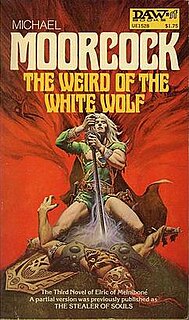
Elric of Melniboné is a fictional character created by English writer Michael Moorcock and the protagonist of a series of sword and sorcery stories taking place on an alternative Earth. The proper name and title of the character is Elric VIII, 428th Emperor of Melniboné. Later stories by Moorcock marked Elric as a facet of the Eternal Champion.

Warhammer Fantasy is a fictional fantasy universe created by Games Workshop and used in many of its games, including the table top wargame Warhammer Fantasy Battle, the Warhammer Fantasy Roleplay (WFRP) pen-and-paper role-playing game, and a number of video games: the MMORPG Warhammer Online: Age of Reckoning, the strategy games Total War: Warhammer, Total War: Warhammer II and Total War: Warhammer III and the two first-person shooter games in the Warhammer Vermintide series, Warhammer: End Times - Vermintide and Warhammer: Vermintide 2.

Eric Rücker Eddison, CB, CMG was an English civil servant and author, writing epic fantasy novels under the name E. R. Eddison. His notable works include The Worm Ouroboros (1922) and the Zimiamvian Trilogy (1935–1958).

The Sword of Shannara is a 1977 epic fantasy novel by American writer Terry Brooks. It is the first book in a titular trilogy.
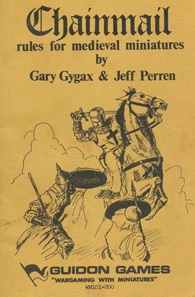
Chainmail is a medieval miniature wargame created by Gary Gygax and Jeff Perren. Gygax developed the core medieval system of the game by expanding on rules authored by his fellow Lake Geneva Tactical Studies Association (LGTSA) member Perren, a hobby-shop owner with whom he had become friendly. Guidon Games released the first edition of Chainmail in 1971.

In many works of modern fantasy, elves are depicted as a race or species of pointy-eared humanoid beings. These depictions arise from the álfar of Norse mythology influencing elves in fantasy as being semi-divine and of human stature, whose key traits are being friendly with nature and animals. However, this differs from Norse and the traditional elves found in Middle Ages folklore and Victorian era literature.
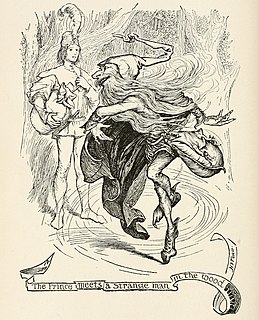
Elements of the supernatural and the fantastic were an element of literature from its beginning. The modern genre is distinguished from tales and folklore which contain fantastic elements, first by the acknowledged fictitious nature of the work, and second by the naming of an author. Works in which the marvels were not necessarily believed, or only half-believed, such as the European romances of chivalry and the tales of the Arabian Nights, slowly evolved into works with such traits. Authors like George MacDonald created the first explicitly fantastic works.

The Ballantine Adult Fantasy series was an imprint of American publisher Ballantine Books. Launched in 1969, the series reissued a number of works of fantasy literature which were out of print or dispersed in back issues of pulp magazines, in cheap paperback form—including works by authors such as James Branch Cabell, Lord Dunsany, Ernest Bramah, Hope Mirrlees, and William Morris. The series lasted until 1974.

The elf is a humanoid race in the Dungeons & Dragons fantasy role-playing game, one of the primary races available for player characters, and play a central role in the narratives of many setting worlds of the game. Elves are renowned for their grace and mastery of magic and weapons such as the bow and sword. Becoming physically mature by the age of 25 and emotionally mature at around 125, they are also famously long-lived, capable of living more than half a millennium and remaining physically youthful. Possessed of innate beauty and easy gracefulness, they are viewed as both wondrous and haughty by other races; however, their natural detachment is seen by some as introversion or xenophobia. They were usually antagonistic towards dwarves.

Robert Paul Holdstock was an English novelist and author best known for his works of Celtic, Nordic, Gothic and Pictish fantasy literature, predominantly in the fantasy subgenre of mythic fiction.

Three Hearts and Three Lions is a 1961 fantasy novel by American writer Poul Anderson, expanded from a 1953 novella by Anderson which appeared in Fantasy & Science Fiction magazine.
Elizabeth Hall Boyer is an American fantasy author who produced a number of books in the 1980s and early 1990s. Her stories were deeply influenced by Norse mythology, and are set in a fantasy world whose climate and geography resembles that of the Scandinavia of Norse myths. While Norse mythology has been an influence on the fantasy genre, and many authors such as Tolkien and Lewis were influenced by these myths, Boyer's books followed them much more closely. Her stories are characterized by light and dark elves, dwarves, trolls, sorcerers, ley lines, burial mounds, wizards, and so forth. Boyer tended to follow the Norse versions of these story elements closely without much deviation. Boyer's early books are dominated by the theme of the heroic quest.

Dragons, Elves, and Heroes is an American anthology of fantasy short stories, edited by American writer Lin Carter. It was first published in paperback by Ballantine Books in October 1969 as the sixth volume of its Ballantine Adult Fantasy series. It was the first such anthology assembled by Carter for the series, issued simultaneously with the second, The Young Magicians.
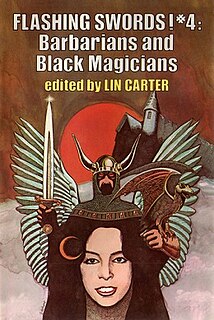
Flashing Swords! #4: Barbarians and Black Magicians is an anthology of fantasy stories, edited by Lin Carter. It was first published in hardcover by Nelson Doubleday in May 1977 as a selection in its Science Fiction Book Club, and in paperback by Dell Books in November 1977.
In J. R. R. Tolkien's legendarium, Elves are a fictional race inhabiting Middle-earth in the remote past. Unlike Men and Dwarves, Elves are immortal. They appear in The Hobbit and in The Lord of the Rings, but their history is described more fully in The Silmarillion.
The Balrog Awards were a set of awards given annually from 1979 to 1985 for the best works and achievements of speculative fiction in the previous year. The awards were named after the balrog, a fictional creature from J. R. R. Tolkien's Middle-earth legendarium. The awards were originally announced by editor Jonathan Bacon in Issue #15 of Fantasy Crossroads and presented at the Fool-Con II convention on April Fool's Day, 1979 at Johnson County Community College, Kansas. The awards were never taken seriously and are often referred to, tongue-in-cheek, as the "coveted Balrog Awards".
This is the complete list of works by American fantasy author Terry Brooks.
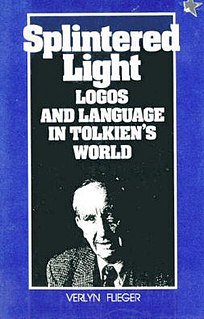
Splintered Light: Logos and Language in Tolkien's World is an 1983 book of literary criticism by the leading Tolkien scholar Verlyn Flieger, in which she argues that light is a central theme of Tolkien's Middle-earth mythology, in particular in The Silmarillion. It has been admired by other scholars to the extent that it has become a core element of Tolkien scholarship.
















